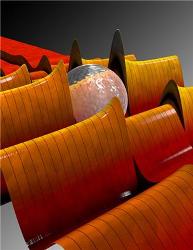A research team comprising global scientists at the Max Planck Institute of Quantum Optics has been able to manage and monitor speeded up electrons from nano-spheres featuring short and strong laser pulses.
Strongly focused laser light reacts with electrons in nanoparticles comprising multitudes of individual atoms to induce these electrons to be emitted and speeded up. This impact of silica in nano-spheres was recently discovered by the team in the Laboratory for Attosecond Physics (LAP) at the MPQ. Strong electrical fields or near-fields accumulate close to the nanoparticles and discharge electrons. The discharged electrons are speeded up as a result of all the communication between the charges and near fields due to ionization caused by the laser light. The precise electrons motion can be monitored through the electric field of the laser. The discovery could help produce strong extreme ultraviolet (XUV) radiation.
 MPQ's Amplified near-fields at the poles of a silica nanosphere
MPQ's Amplified near-fields at the poles of a silica nanosphere
The three German groups comprised Professor Matthias Kling, Laboratory for Attosecond Physics (LAP) at the Max Planck Institute of Quantum Optics in Garching and the Ludwig-Maximilian University Munich, Professor Eckart Rühl, Free University of Berlin and Professor Thomas Fennel, University of Rostock.
Silica nanoparticles were lit with 100nm intense light pulses for five femtoseconds. The short laser pulses comprised a few wave cycles. Each nanoparticle was made up of 50 million atoms. The electrons were ionized in a fraction of a femtosecond and speeded up by the electric field. Some electrons move less than a nano-meter away from the nano-sphere surface, but the laser field can force them to return to the surface to be ricocheted back. The energy thus derived by the electrons can be very high.
The team recorded the direct elastic recollision from a nanosystem. Polarized light waves swung only along one axis in one direction. Eckart Rühl says intense radiation pulses could damage or silence nanoparticles. So the nanoparticles had to be prepared in a beam, with fresh particles for each pulse. The electrons led to multiple directions and energies. The movement was captured in a three-dimensional image that helped analyze the energies and travel directions of the electrons. The electrons were speeded up both by the near-field and the communication with other electrons, according to Matthias Kling.